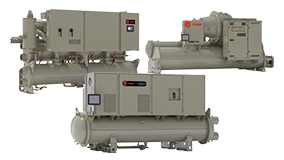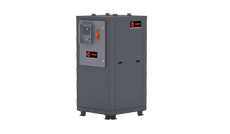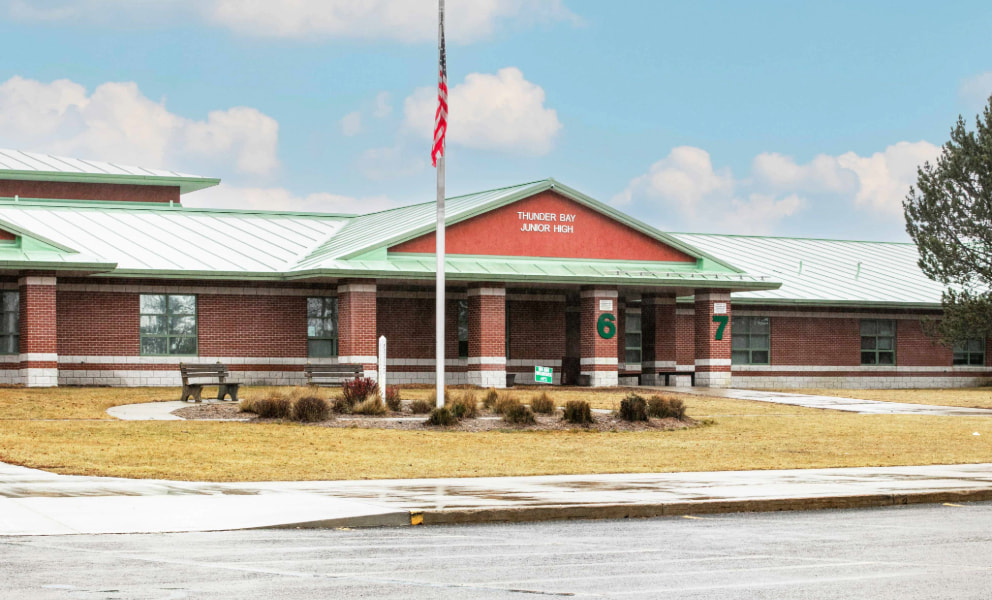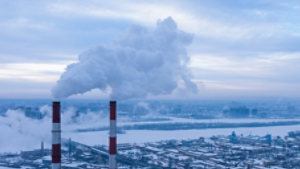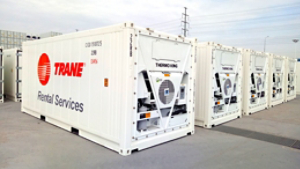Location: Michigan
Industry: K-12
Products Used: Lighting, Building Automation Systems
Topic: Sustainability, Cost-Saving, IEQ, Connected Buildings
- $375,000 annual energy and operating savings
- 1.919 mt of CO2e reduction
The Challenge: How Can Schools Save Money with Aging Infrastructure?
Alpena Public Schools in Alpena, Michigan, faced aging facilities and infrastructure which negatively impacted the learning environment for its 3,900 largely rural students. One of the largest geographic districts in Michigan, Alpena Schools covers more than 600 square miles. adjacent to Lake Huron’s Thunder Bay.
The district wanted to update 11 buildings to help ensure the district’s ability to provide a dry and comfortable learning environment for its students, teachers and staff while helping to lower energy and operational costs. The academic environment consistently proved uncomfortably hot or cold with students wearing jackets or falling asleep in 80-degree-plus rooms.
A district assessment uncovered deteriorating equipment as well as inadequate and outdated building automation system (BAS) controls. Other challenges included leaking roofs, improperly sealed building envelopes1, bad lighting, old plumbing fixtures, asbestos, and myriad inefficiencies plaguing operating costs. Some systems were even running 24/7, burning out motors and risking fires. The district maintenance team was spending at least one full day a week just keeping things running. The district was ready for improvements but needed the funding to make them happen.
The Solution: Future Savings for Present Needs
When Trane reached out to the Alpena Public Schools superintendent to discuss district needs, the timing was perfect as they were looking for an energy consultant to address their building and funding challenges. Trane proposed a guaranteed energy saving performance contract (GESPC) which would enable the district to pay for upgrades with future energy savings – and the district wholeheartedly agreed.
In March 2020, Alpena passed a $34 million bond to fund the upgrades, which was combined with the GESPC, enabling the district to pay for an additional $7.1 million in improvements. “The district needed creative funding solutions and a reliable source to help them fund those solutions,” Trane Comprehensive Energy Solutions Partner Gwen Pettit said. “The energy performance contract helped make that happen.”
Trane worked with the district to develop a holistic plan to enhance the academic environment. Trane helped focus Alpena Public School’s upgrade plans on its most vital requirements: heat and energy. Planning was just the first step. The next would see Trane managing and implementing the upgrades with the contractors, engineers, and the school district.
The team focused first on completing upgrades that would generate the biggest cost savings.
For example, the team added a centralized BAS system that enables the maintenance team to manage systems remotely. “I can control and check on the entire system with my phone from the road, from my deer blinds and from the board room,” Alpena Public Schools Facilities and Maintenance Director Kurt Konieczny said.
Another improvement included upgrading seven boiler rooms to help ensure comfort for students, teachers and staff throughout the district. Rather than simply turning on and off, the new fully modulating boiler systems offer 20 different performance levels to meet the specific comfort need at a particular time. Boilers may run at 10 percent, for example, when it’s 50 degrees out – keeping temperatures at an optimal level. “We’re not “cooking” the students and staff out of the rooms like the systems used to do,” said Konieczny, “We’re keeping it comfortable.” Boiler room upgrades also included asbestos abatement.
The project also included sealing facilities’ building envelopes to improve building performance and replacing leaky faucets and running toilets with water-saving, low-flow toilets and sinks. They also either replaced or retrofitted every light in the district: with LED bulbs to improve illumination for optimized learning in classrooms and safety and comfort in areas such as hallways and parking lots.
Trane provided consultations when they were needed throughout the upgrade process. By collaborating with Trane, the Alpena Public School administration was able to effectively communicate with its community and media on the improvements being made to its infrastructure.
The Results: Huge Improvements While Saving Money
The completed upgrades now provide a dry and comfortable academic environment that supports student education and well-being — all while conserving water and saving energy and operational costs.
The upgrades are generating annual energy and operating savings of more than $375,000. The district also received a combined one-time utility rebate of $192,636 from Alpena Power and DTE Energy.
The project also significantly reduced the district’s carbon footprint. It reduced CO2e emissions by 1.919 metric tons2, which is equivalent to nearly 5 million miles driven by the average gasoline-powered passenger vehicle and carbon sequestered by 2.288 acres of trees.
New energy efficient HVAC systems help ensure consistent building comfort while improved lighting has enhanced the classroom environment to help optimize learning. Properly sealed building envelopes enable the district to use energy more efficiently and effectively.
Upgraded systems no longer require excessive maintenance, increasing facilities staff’s productivity by giving them back a full workday each week. “There’s less firefighting and there’s more time to actually maintain and keep things operational and in top shape,” said Konieczny.
District leaders are very pleased with the end results and the process it took to get there. Konieczny explained that with some projects, things get underway and the unexpected happens. “We didn’t really see that,” he said. “Everything was thoroughly planned out so when we hit the “start” button, everything worked as it should.
Decarbonization Strategies for K-12 Schools
Reducing carbon emissions to create healthier, more productive learning environments












































